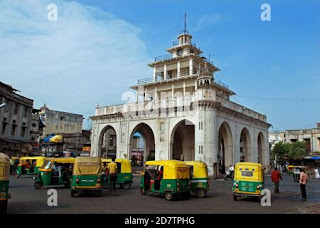Mandvi Gate of Gujarat state holds a significant place in Vadodara’s composite cultural and historical landscape. Serving as a major landmark, it continues to be a focal point for cultural activities, festivals, and large public gatherings, evoking a deep sense of pride and identity among local artists, historians, and citizens.
 |
| Mandvi Gate, Vadodara city, GJ.in.pinterset.com |
 |
| Mandvi Gate, Vadodara city, GJ Alamy.com |
Above image: Mandvi Gate, Vadodara, GJ:: Originally built by Sultan Muzaffer (1511-26 CE) in the first quarter of 16th Century it was renovated by Shri Damaji Rao II in 1736 when the square shaped pavilion measuring 4 , 000 sq . feet had only one storey featuring 3 bold arched openings on each side.......
Located at the exact midpoint of the old walled city, Mandvi Gate is not merely an entrance but a grand pavilion or "Mandapa" standing at the intersection of the city's two cardinal streets. The name Mandvi is derived from the Sanskrit word mandapa, meaning a pillared hall. This solitary structure forms a part of the larger historical context connected to Kila-e-Daulatabad, the erstwhile fort of Baroda (designed by Rumin Khan). Mandvi pavilion and the gate remain remnants of the past era. As for the pavilion it was a double-story structure and during the reign of the Gaekwads, the pavilion assumed some significance. It was also used as a platfrom to make public announcement.
Historically, Mandvi Gate was used to collect tolls from merchants and traders and served as a platform for public announcements. Built during the reign of Sultan Muzaffar (1511–1526 AD), it was later renovated in 1736 AD under the orders of Damaji Rao II by Governor Malharao Maloji. In 1856, Ganpatrao Gaekwad further enhanced the structure by adding two additional storeys and installing a clock at the top. The pavilion features a spiral staircase to access upper levels and over a period changes were out of necessity. The stair case tower moved to the NE side, converting the upper wooden floors into RCC concrete. To retain the heritage aspect, wooden jaalis remain unchanged as they are intact. During the reign of Gaekwad, the royal family's fag was hoisted in the morning and lowered at dusk to the accompaniment of blowing of trumpet, cannon shots and beating of huge Nagara drum. The ruler's horse-drawn carriage, Maharajah's elephant and in the later years his RR cars used to pass through the arches, drawing the attention of the common people nearby.
 |
| Mandvi Gate, Vadodara city, GJ upload.wikimedia.org image credit. Snehrashm |
Today, Mandvi Gate stands as a four-storied concrete structure adorned with intricate jaalis (lattice screens). Despite the passage of time, much of its original architecture remains intact. During special occasions, festivals, and cultural events, the gate is illuminated with vibrant lights, transforming it into a magnificent spectacle that continues to captivate residents and visitors alike. The Mandi gate is, no doubt, intertwined with the cultural and historical aspects of this place.



.jpg)





